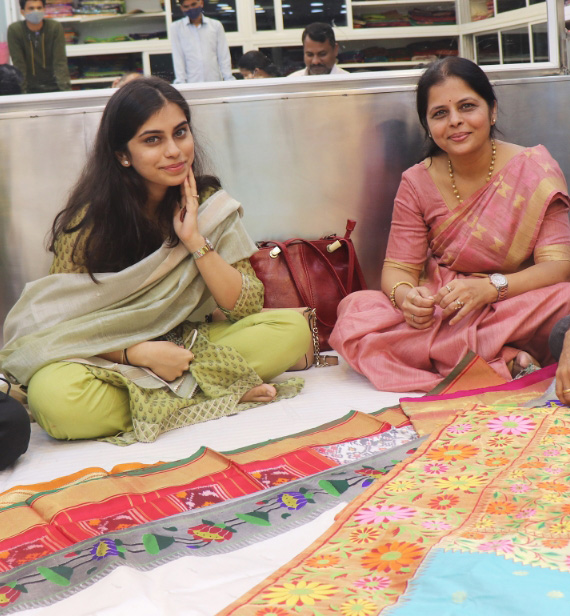Paithani Weaving Art
Handloom Industry In Maharashtra
The handloom industry in Maharashtra is decentralised and is concentrated in a few regions. Indian Handloom census reveals that there are 3,435 weaver families in Maharashtra, out of which 2445 live in urban areas and 990 families live in rural areas. Handloom sector also exhibits regional features and the respective products carry regional names, such as Nagpuri Sarees, Mehendargi Choli Khan and so on.
The handloom industry in Maharashtra has lost its supremacy on account of many factors such as lack of good expertise in weaving, shortage of raw material, dearth of capital and little governmental support. Yet there is scope for improvement through technological advances, decentralisation, removing glitches in distribution, etc. As per the fourth handloom census, there are 3435 weaver families in Maharashtra, out of whom 2445 live in urban areas and 990 families in rural regions.
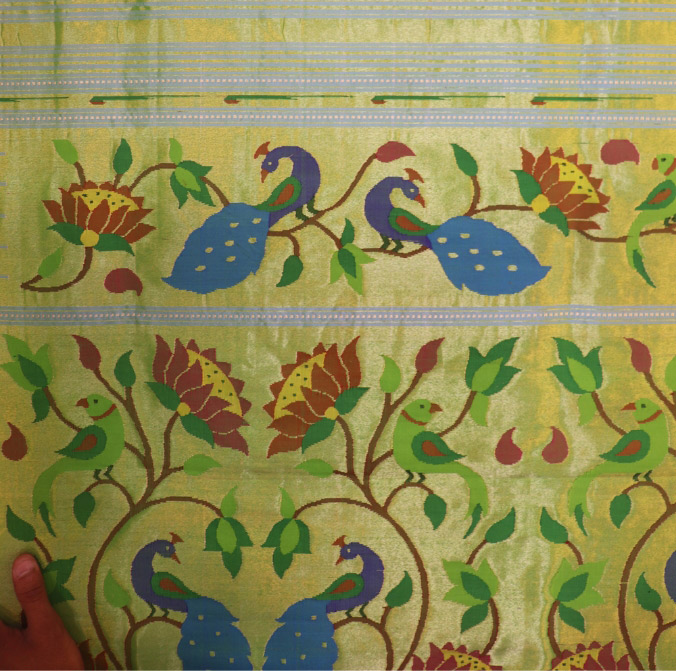
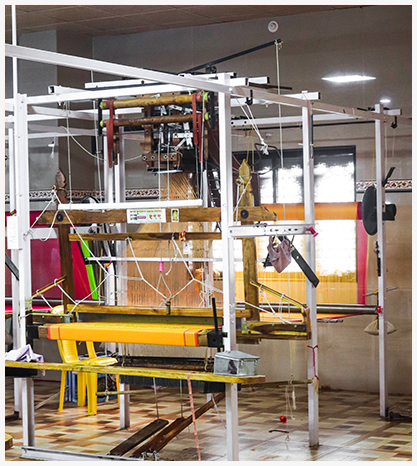
History of Paithani
The art of Paithani weaving is two thousand years old. It was born in Paithan, which then was 'Pratishthan'. Paithan town is situated 50 kms from Aurangabad on the banks of river Godavari. In olden days Paithan was an international market in Silk and Zari. The Satvahan period saw the trade and commerce in Paithan reach the peak. Muslin was the speciality at that time.
A Glance At The Process Of Making A Paithani
The Paithani with patterns of peacocks that we see today, is a product of various processes. The process of creating a Paithani comprises of a number of independent but interconnected steps. Let us review these steps in their order.

- Grading, Winding And Rotating
Cloth undergoes some stretching on a handloom. A process involving three stages is done on raw silk so that it becomes strong enough to endure the tension. These three stages are grading, winding and rotating. The weave of the tension has to be tighter while weaving silk. This weave provides support as it takes on the tension of the handloom. This process converts raw silk into woven cloth.
- Bleaching, Dyeing And Shaping
The wound and rotated silk is sent to the dyer. Bleaching is done by immersing it in a boiling solution of Sodium Carbonate. Bleaching turns the silk white and removes all impurities. Dyes are mixed in hot water to obtain the desired effect. The process of dyeing makes silk cloth slack. Silk is sized with Arrowroot glue, sugar, gum and honey so as to make the silk cloth strong enough to undergo weaving.
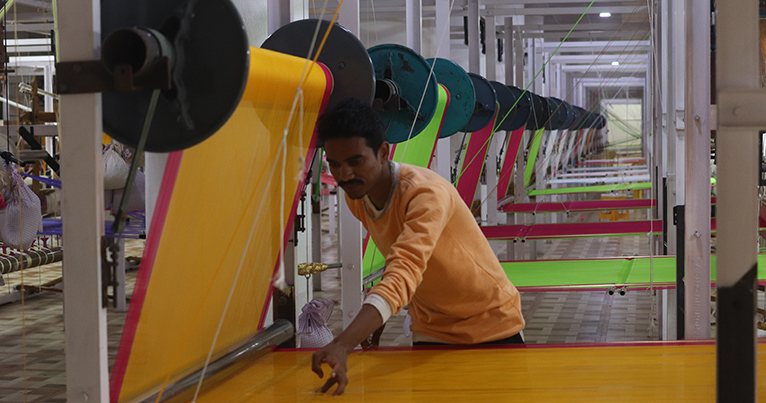

- Threading With Gold And Silver
Weavers do the weaving with golden or silver threads or threads of some other colour suitable to the design. A machine called Jobby is fitted to the handloom, which imparts speed to the handloom. It helps in doing the design of the border. A saree with a lot of complicated design is more difficult to weave and the saree become proportionately more expensive.
- Designing
Once the weaving is over, the saree is removed from the handloom and sent for cutting it to proper size. The brokade looks very attractive on account of the intricate design. The speciality of the Paithani weaver lies in the way he weaves the threads into the cloth while doing the design. Every colour in the design has its own specific bamboo shaft. Instead of using a drawing or some such object, the weavers do the weaving as required by the intricate design using the vertical thread in the cloth.
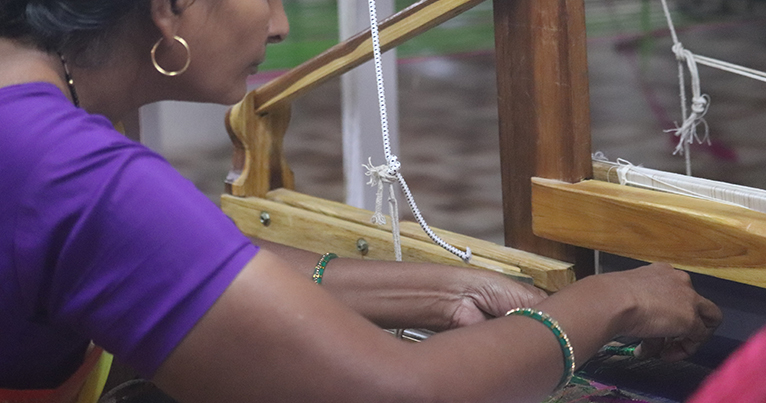
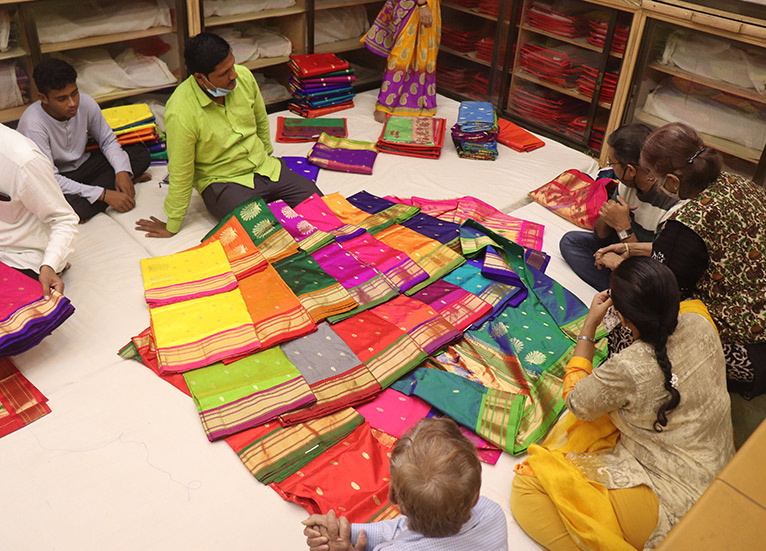
- Paithani Saree
Weavers do the weaving with golden or silver threads or threads of some other colour suitable to the design. A machine called Jobby is fitted to the handloom, which imparts speed to the handloom. It helps in doing the design of the border. A saree with a lot of complicated design is more difficult to weave and the saree become proportionately more expensive.
Eventhough the splendour of the Paithani is well known, its authenticity is not easy to make out. Paithani’s woven on powerlooms are equally popular today. Though time tempers tall claims, the silk Paithani woven on a handloom remains a class apart. Kapse Group is committed to creating awareness about the Paithani in general and also to elucidate things for the connoisseur because, you see, the original is always unbeatable!
Conservation Of The Art Of Weaving A Paithani
The Heritage Of A Magnificent Tradition Must Be Protected
With time, the breed of expert Paithani weavers is vanishing along with their talent and only a handful of them practise the art today. If the art is to survive and regain its past glory, a plan has to be drawn and implemented without delay. The art of Paithani weaving in Maharashtra is not only ancient and uncommon but it reflects the essence of an exceptional talent. The Paithani, woven on a handloom with the delicate gift of expertise, is faced with terrible competition from Paithani’s woven on powerlooms today. As we know, Paithani with its gold threads has been an integral part of a bridal costume. Kapse Paithani Park aims to preserve and propagate the matchless art of making a Paithani on the handloom. The park will have a museum where, along with the history of the Paithani, the mesmerizing art of Paithani making will also be showcased.
What Is Our Position?
The construction of Kapse Paithani Complex is proceeding at a brisk pace. It will showcase and promote the splendour of the beautiful Paithani and we are trying to make it convenient for celebrities and brides and their families and their entourage to buy Paithani’s they fancy and they will also be able to witness our Paithani conservation efforts.
- Building an integrated complex
The raw material required for the Paithani, the process before and after the weaving, points of retail and wholesale sale are not available under one roof today. With due attention to all these factors. we are planning to develop an integrated complex to have everything at one place.
- Anything for a Paithani
The Paithani Complex will house 2000 handlooms. It is also proposed to have a sales chamber of 90 thousand sq. ft. There will be a storage facility for Paithani’s, a dyeing centre and a residential facility for the weavers working there.
- Full scale wedding purchases made easy
There is a tradition of Basta - large scale purchasing of clothes - for weddings, in which a number of family members participate. Separate spacious rooms will be provided for such families who come for large scale purchases where they can make their purchases at their leisure.
- Special arrangements for visitors
The guests and buyers visiting Paithani Park will have refreshment facilities which will accommodate 100 people. This facility will be ready by 2021.
- A plan for silk manufacture
The silk cloth of the Paithani requires silk yarn and plans are being made to produce silk yarn here. Study is under way and a professional survey has been conducted.
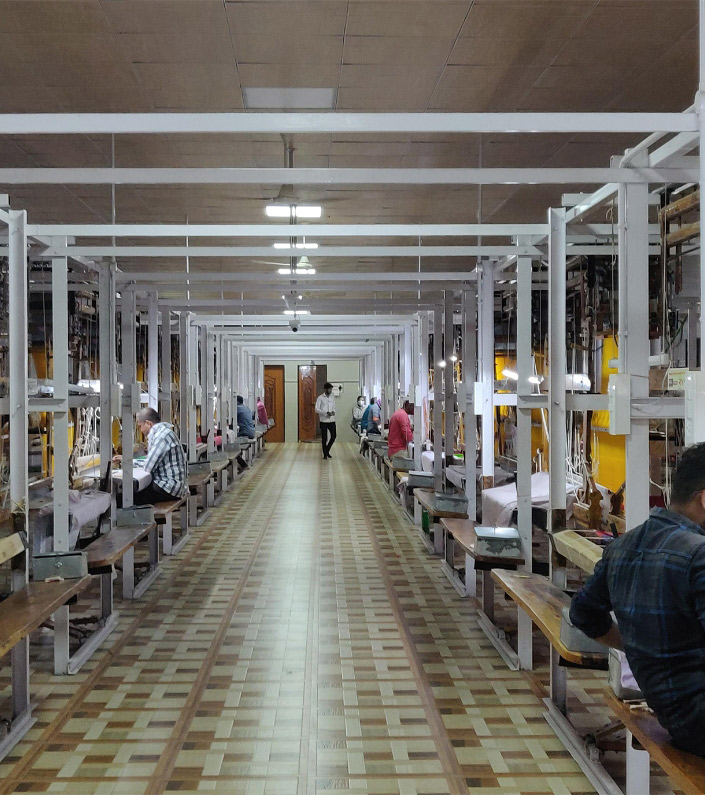
Types of Paithanis
A Paithani need not necessarily have peacocks on it. There are various types of Paithani’s and each type takes its own time and its own efforts. All of them of course test the skills and the patience of the weaver. The end product is always a breath-taking artwork. The types, in general, are as follows:
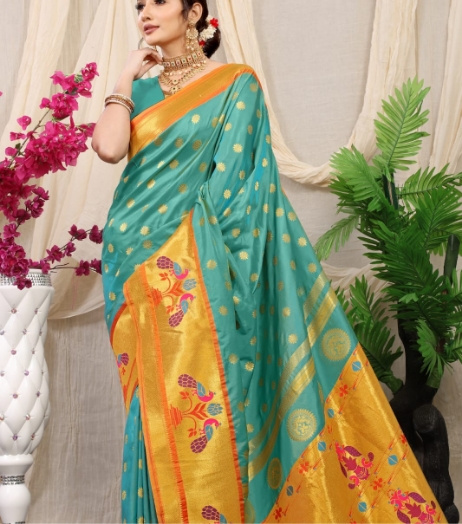
Bracelet Peacock Paithani
The most common image of a Paithani has peacocks dancing on it. The weavers call it 'बांगडी मोर' - bracelet peacock. This kind of design is ordinarily woven on the पदर, the outermost portion of a saree. This is the most commonly used design of a Paithani saree.

Single-Piston Paithani
A single piston is used to weave the vertical threads of a single-piston saree. The horizontal and the vertical threads have different colours. These sarees have a 'coconut border' and there is a simple but peculiar design called बुट्टी - butti - on it. The shape of the 'butti' could be that of a coin or of a pea.

Traditional Paithani
Even though a Paithani always stands out irrespective of its colour; it mostly has one of the three colours: pitch black 'Chandrakala' (black saree with a red border), Raghoo (green like a parakeet) and Shirodak (bright white). Demand for such traditional Paithani’s is the highest.

Brocade Paithani
